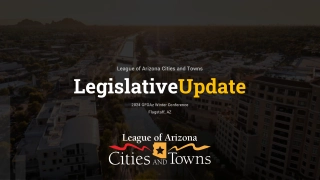Small Towns Conference
This research project aims to define and evaluate financial capacity in small towns without the need for annual audits. It explores challenges faced by small towns in managing finances, particularly in light of the pandemic's impact. Participants from Virginia towns share insights on measuring financial capacity, updating officials, and providing guidance to others.
Download Presentation

Please find below an Image/Link to download the presentation.
The content on the website is provided AS IS for your information and personal use only. It may not be sold, licensed, or shared on other websites without obtaining consent from the author.If you encounter any issues during the download, it is possible that the publisher has removed the file from their server.
You are allowed to download the files provided on this website for personal or commercial use, subject to the condition that they are used lawfully. All files are the property of their respective owners.
The content on the website is provided AS IS for your information and personal use only. It may not be sold, licensed, or shared on other websites without obtaining consent from the author.
E N D
Presentation Transcript
Defining Local Government Financial Capacity Stephanie Dean Davis Collegiate Associate Professor
Defining Local Government Financial Capacity Financial capacity is defined as the local government's ability to utilize financial resources to provide stable delivery of public services and to deal with future events. Think about financial capacity as the ability to actually spend money and get things done on behalf of your citizens; having the ability to weather financial downturns, etc. But, how do we measure this in our day-to-day work of managing local government finances?
Goals of the Study This research project was funded in partnership with the Virginia Municipal League and the College of Liberal Art and Human Sciences at Virginia Tech. Goals: Define local government financial capacity Develop a tool to help small towns evaluate their financial capacity without the need or requirement for an annual audit Understand challenges in small towns given previous research on financial impacts from the pandemic
Study Participants and Process 38 out of 190 Towns in Virginia 38 Towns are required by State Code to conduct an annual audit of their financial statements 142 are exempt per State Code 15.2-2510- population of less than 3,500 10 in-person interviews were conducted in March 2024 Survey was developed and sent out in April 2024 28 of the 38 Towns responded 74% response rate 19 Towns Managers responded/21 Treasurer/Finance Directors responded.
Research Questions How do Towns measure financial capacity and how important are those factors? How do Towns view the importance and impact of the APA report on Fiscal Distress in Virginia Local Governments? How, when and by what methods do Towns update elected officials on the Town s financial status? What guidance would Town s provide to other Towns to understanding their financial capacity?
Financial Capacity How do you know if you have funds sufficient to provide government services?
How do you measure financial capacity on an annual basis? Item Percentage Adopting a balanced budget General Fund Unassigned Fund Balance levels "Clean" unmodified audit opinion Compliance with adopted financial policies Low debt levels Adoption of a capital improvement plan Tax collection percentages - low uncollectible amounts Cash funding for capital projects Budget Stabilization Fund levels Credit Rating Fiscal Distress Monitoring Ratios Other grant funding, revenue projections Total 13.64% 12.73% 12.73% 12.27% 10.00% 9.09% 8.64% 8.64% 3.64% 3.64% 2.73% 2.27% 100.00%
What factors are most important to measuring financial capacity? Very and Extremely Important Not at all important Slightly important Moderately important Very Extremely important Statement important Adopting a balanced budget General Fund Unassigned Fund Balance Levels 0.00% 0.00% 3.13% 31.25% 65.63% 96.88% 3.13% 6.25% 3.13% 43.75% 43.75% 87.50% Compliance with adopted financial policies 0.00% 0.00% 12.50% 43.75% 43.75% 87.50% "Clean" unmodified audit opinion 3.13% 0.00% 9.38% 34.38% 53.13% 87.50% Cash funding for capital projects 0.00% 4.17% 16.67% 54.17% 25.00% 79.17% Adoption of a capital improvement plan 3.13% 9.38% 18.75% 25.00% 43.75% 68.75% Low debt levels 0.00% 9.68% 25.81% 38.71% 25.81% 64.52% Tax collection percentages-low uncollectible amounts 6.90% 6.90% 24.14% 37.93% 24.14% 62.07% Budget Stabilization Fund levels 9.38% 18.75% 21.88% 37.50% 12.50% 50.00% Fiscal Distress Monitoring Ratios 20.00% 13.33% 36.67% 30.00% 0.00% 30.00% Credit Rating 16.67% 13.33% 43.33% 6.67% 20.00% 26.67%
Adopting a balanced budget 70% 65.62% 60% 50% 40% 31.25% 30% 20% 10% 3.12% 0.00% 0.00% 0% Not at all important Slightly important Moderately important Very important Extremely important
General Fund Unassigned Fund Balance Levels 50% 43.75% 43.75% 45% 40% 35% 30% 25% 20% 15% 10% 6.25% 5% 3.12% 3.12% 0% Not at all important Slightly important Moderately important Very important Extremely important
Compliance with adopted financial policies 50% 43.75% 43.75% 45% 40% 35% 30% 25% 20% 15% 12.50% 10% 5% 0.00% 0.00% 0% Not at all important Slightly important Moderately important Very important Extremely important
Financial Policies
Do you have adopted financial policies? 100% 87.10% 90% 80% 70% 60% 50% 40% 30% 20% 12.90% 10% 0% Yes No
If you have financial policies, what types of financial policies do you currently have? 25% 21.88% 20% 18.75% 16.41% 15% 14.06% 13.28% 12.50% 10% 5% 3.12% 0% Fund Balance Policies Debt Investment Policies Operating Budget Policies Revenue Policies Capital Budget Policies Other Management Policies
If you have financial policies, how often do you monitor compliance with your financial policies? 80% 71.88% 70% 60% 50% 40% 30% 20% 15.62% 12.50% 10% 0.00% 0.00% 0% Annually Monthly When we issue debt Never Other
Has or does your town utilize the services of a municipal financial advisor? 80% 75.00% 70% 60% 50% 40% 30% 25.00% 20% 10% 0% Yes No
How would your town handle the situation that you were not in compliance with a financial policy? Notification and Disclosure: Inform management and council about non-compliance. Involve financial advisors and other relevant parties. Disclose issues to the CAO and council. Communicate with the Town Manager, council, auditors, debt holders, and citizens. Consult with auditors and determine a plan for compliance. Evaluate the situation with the Finance Director.
How would your town handle the situation that you were not in compliance with a financial policy? Policy Modifications: Present modifications to the council and, if necessary, make permanent changes to the policy. Discuss the policy's purpose and value to ensure alignment with intended goals. If the policy is outdated, address it with the council. Implement corrective measures and policy adjustments as needed. Noncompliance Plan of Action: Council must adopt a plan in the next budget cycle to address non- compliance. Take steps to mitigate and prevent future occurrences. Establish safeguards and alerts. Implement corrective actions and safeguards. Create a plan and timeline for compliance. Obtain council approval and endorsement for the plan. Call in an advisor for investigation and recommendation. Determine the severity and develop a corrective action plan.
Fiscal Distress Monitoring for Local Governments Auditor of Public Accounts
Auditor of Public Accounts Fiscal Distress Monitoring Report https://www.apa.virginia.gov/local- government/reports?type=fiscal-distress-monitoring
Are you aware of the Fiscal Distress Monitoring report and process that is completed by the State Auditor of Public Accounts? 90% 81.25% 80% 70% 60% 50% 40% 30% 18.75% 20% 10% 0% Yes No
If you are aware of the report, do you use this report as a measure of financial capacity for your town? 80% 70.00% 70% 60% 50% 40% 30.00% 30% 20% 10% 0% Yes No
Do you share the report with your elected officials (council, mayor)? 80% 73.33% 70% 60% 50% 40% 30% 26.67% 20% 10% 0% Yes No
Do you use just the financial ratios as a measure of financial capacity for your town? 70% 63.33% 60% 50% 40% 36.67% 30% 20% 10% 0% Yes No
Updating Elected Officials on Financial Status
How often do you update the governing body/elected officials on the financial status of the Town? Answer Percent Annually 29.55% Quarterly 13.64% Once a month 52.27% Never 0.00% Other 4.55% Total 100%
How do you communicate financial information to the governing body? Answer Count Percent Annual Audit Presentation 31 26.05% Through the budget process 28 23.53% Monthly council package/financial status report Respond to individual council member requests 25 21.01% 24 20.17% Quarterly Financial report 9 7.56% Other 2 1.68%
How important are the following financial reports or data in reporting to the governing body? What does the governing body want to know about the Town's financials? Very and Extremely Important Not at all important Slightly important Moderately important Very Extremely important Statement important Summary revenue and expenditures by fund year to date 0.00% 6.25% 15.63% 37.50% 40.63% 78.13% Detail Budget to Actuals for Revenues and Expenditures - year to date 3.13% 6.25% 18.75% 31.25% 40.63% 71.88% Cash Balances year to date 3.13% 6.25% 28.13% 21.88% 40.63% 62.50% Accounts payable listings (monthly) 34.38% 21.88% 12.50% 15.63% 15.63% 31.25%
Summary revenue and expenditures by fund year to date 45% 40.62% 40% 37.50% 35% 30% 25% 20% 15.62% 15% 10% 6.25% 5% 0.00% 0% Not at all important Slightly important Moderately important Very important Extremely important
Detail Budget to Actuals for Revenues and Expenditures - year to date 45% 40.62% 40% 35% 31.25% 30% 25% 18.75% 20% 15% 10% 6.25% 5% 3.12% 0% Not at all important Slightly important Moderately important Very important Extremely important
Cash Balances year to date 45% 40.62% 40% 35% 30% 28.12% 25% 21.88% 20% 15% 10% 6.25% 5% 3.12% 0% Not at all important Slightly important Moderately important Very important Extremely important
Accounts payable listings (monthly) 40% 34.38% 35% 30% 25% 21.88% 20% 15.62% 15.62% 15% 12.50% 10% 5% 0% Not at all important Slightly important Moderately important Very important Extremely important
Economic Vulnerability
Based on your current financials, do you think your Town is prepared for an economic downturn? 120% 96.88% 100% 80% 60% 40% 20% 3.12% 0% Yes No
How important are the following for the town to be prepared for an economic downturn? Very and Extemely Important Not at all important Slightly important Moderately important Very Extremely important Statement important General Fund Unassigned Fund Balance Levels Adopting a balanced budget Compliance with adopted financial policies 0.00% 0.00% 6.25% 0.00% 0.00% 6.25% 37.50% 40.63% 56.25% 53.13% 93.75% 93.75% 0.00% 9.38% 15.63% 43.75% 31.25% 75.00% Tax collection percentages-low uncollectible amounts Low debt levels 3.57% 0.00% 7.14% 6.45% 21.43% 25.81% 50.00% 38.71% 17.86% 29.03% 67.86% 67.74% Adoption of a capital improvement plan Budget Stabilization Fund levels "Clean" unmodified audit opinion Cash funding for capital projects Fiscal Distress Monitoring Ratios Credit Rating 0.00% 6.45% 3.23% 0.00% 9.68% 16.67% 3.13% 12.90% 9.68% 8.00% 9.68% 20.00% 31.25% 16.13% 22.58% 32.00% 45.16% 33.33% 53.13% 35.48% 25.81% 44.00% 22.58% 16.67% 12.50% 29.03% 38.71% 16.00% 12.90% 13.33% 65.63% 64.52% 64.52% 60.00% 35.48% 30.00%
General Fund Unassigned Fund Balance Levels 60% 56.25% 50% 40% 37.50% 30% 20% 10% 6.25% 0.00% 0.00% 0% Not at all important Slightly important Moderately important Very important Extremely important
Adopting a balanced budget 60% 53.12% 50% 40.62% 40% 30% 20% 10% 6.25% 0.00% 0.00% 0% Not at all important Slightly important Moderately important Very important Extremely important
Scenario: A small town asks you for help in understanding their financial capacity. What would you recommend they do to ascertain their financial capacity? Leverage External Resources Start by requesting policies from other governments. Understand the importance of structural balance in every fund. Engage a municipal financial advisor or benchmark with similar localities. Consult auditors. Meet with the audit firm post-annual review. Reach out to public resources for financial assessments and grants. Consult municipal advisory services for professional assistance. Discuss with external auditors and utilize state-level resources. Use assistance from municipal finance advisors and other localities. Work with auditors and financial management firms.
Scenario: A small town asks you for help in understanding their financial capacity. What would you recommend they do to ascertain their financial capacity? Conduct A Financial Assessment: Review debt to revenue ratio. Conduct revenue vs. expenditure analysis. Assess general fund balance relative to the annual budget and cash for projects. Examine cash balances and unassigned fund balance as a percentage of next year's budget. Evaluate surplus or deficit trends. Perform a 3-year cash flow analysis. Review budget-to-actuals, annual reports, debt schedules, and financial policies. Analyze unassigned fund balance in relation to expenditures. Understand revenue trends and expenditure pressures over the past 5 years. Compare debt to income and evaluate fund balances and credit ratings. Analyze collections and capital projects plans. Survey financial stability, focusing on cash reserves and recurring revenues. Review budget analyses, fund balances, and ratios from APA. Consider balanced budgets, appropriate reserves, and avoiding debt for operational costs. Share financial plans and engage financial directors for additional guidance. Determine specific problems being addressed. Use Fiscal Distress Monitoring Reports and consider economic issues
Scenario: A small town asks you for help in understanding their financial capacity. What would you recommend they do to ascertain their financial capacity? Develop and Build Internal Capacity: Assess internal staff capacity for understanding financial issues. Establish or enhance financial policies and internal reports. Educate elected officials on financial standing and budget processes. Conduct intensive internal reviews aligned with strategic goals. Identify mission essential functions and ensure financial resources for infrastructure and HR during disasters. Evaluate analytical, coordination, delivery, and regulatory capacities for financial management.
Conclusion Unassigned Fund Balance, Adopting a balanced budget and Compliance with Financial Policies are the most important factors of financial capacity. Fund balance financial policies are routinely adopted by Towns. Many towns are aware of the fiscal distress monitoring report but do not use the report as a measure of financial capacity nor are they sharing the report with elected officials. Most towns update elected officials once a month through a summary revenue and expenditure year to date report. Almost all towns believe they are prepared for an economic downturn.
Next Steps Develop a tool for towns exempt from annual audits Volunteers? Please email me at sddavis@vt.edu
Questions Thank you!
What factors are most important to measuring financial capacity? Very and Extremely Important Not at all important Slightly important Moderately important Very Extremely important Statement important Adopting a balanced budget 0.00% 0.00% 3.13% 31.25% 65.63% 96.88% General Fund Unassigned Fund Balance Levels 3.13% 6.25% 3.13% 43.75% 43.75% 87.50% Compliance with adopted financial policies 0.00% 0.00% 12.50% 43.75% 43.75% 87.50% "Clean" unmodified audit opinion 3.13% 0.00% 9.38% 34.38% 53.13% 87.50% Cash funding for capital projects 0.00% 4.17% 16.67% 54.17% 25.00% 79.17% Adoption of a capital improvement plan 3.13% 9.38% 18.75% 25.00% 43.75% 68.75% Low debt levels 0.00% 9.68% 25.81% 38.71% 25.81% 64.52% Tax collection percentages-low uncollectible amounts 6.90% 6.90% 24.14% 37.93% 24.14% 62.07% Budget Stabilization Fund levels 9.38% 18.75% 21.88% 37.50% 12.50% 50.00% Fiscal Distress Monitoring Ratios 20.00% 13.33% 36.67% 30.00% 0.00% 30.00% Credit Rating 16.67% 13.33% 43.33% 6.67% 20.00% 26.67%
Adopting a balanced budget 70% 65.62% 60% 50% 40% 31.25% 30% 20% 10% 3.12% 0.00% 0.00% 0% Not at all important Slightly important Moderately important Very important Extremely important
General Fund Unassigned Fund Balance Levels 50% 43.75% 43.75% 45% 40% 35% 30% 25% 20% 15% 10% 6.25% 5% 3.12% 3.12% 0% Not at all important Slightly important Moderately important Very important Extremely important
Compliance with adopted financial policies 50% 43.75% 43.75% 45% 40% 35% 30% 25% 20% 15% 12.50% 10% 5% 0.00% 0.00% 0% Not at all important Slightly important Moderately important Very important Extremely important
"Clean" unmodified audit opinion 60% 53.12% 50% 40% 34.38% 30% 20% 9.38% 10% 3.12% 0.00% 0% Not at all important Slightly important Moderately important Very important Extremely important























